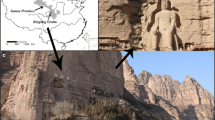Abstract
The values of surface recessions of sandstones in the bottom walls of the ancient World Heritage City of Pingyao were measured using a specially designed movable instrument with the precision of 0.0143 mm. Seventeen sample areas were chosen from four orientations to study the effect of weathering in this semi-arid, unpolluted environment. Each area could be sub-divided into three zones with different weathering degrees but the weathering rates were found to be highest in the south-facing and lowest in the north-facing sandstone walls. The reasons for the differential weathering are discussed and recommendations are made to reduce their effects.
Résumé
Les valeurs d’érosion de surface de grès de la base des murs de l’ancienne ville de Pingyao, inscrite au Patrimoine Mondial de l’Humanité, ont été mesurées avec un dispositif spécialement conçu apportant une précision de 0,0143 mm. Dix-sept surfaces échantillons ont été choisies à partir de quatre orientations pour étudier l’effet de l’altération météorique dans cet environnement semi-aride non pollué. Chaque surface pouvait être divisée en trois zones de différents degrés d’altération. Les taux d’altération sont apparus les plus forts sur les murs de grès regardant le sud et les plus faibles sur les murs de grès regardant le nord. Les raisons de cette altération différentielle sont discutées et des recommandations sont faites pour en diminuer les effets.








Similar content being viewed by others
References
Cooke RU, Inkpen RJ, Wiggs GFS (1995) Using gravestones to assess changing rates of weathering in the United Kingdom. Earth Surf Proc Land 20:531–546
Feng YY, Li HJ (2003) Monitoring and evaluation of acid rain in Shanxi Province. Soil Water Conserv Sci Technol Shanxi 3:17–19 (in chinese)
Gunn DA, Jones LD, Raines MG, Entwisle DC, Hobbs PRN (2005) Laboratory measurement and correction of thermal properties for application to the rock mass. Geotech Geol Eng 23:773–791
Inkpen RJ, Jackson J (2000) Contrasting weathering rates in coastal, urban and rural areas in southern Britain: preliminary investigations using gravestones. Earth Surf Proc Land 25:229–238
Mcneill GW (1999) Variations in the weathering rate of Scottish gravestones as an environmental signature of atmospheric pollution. Environ Geochem Health 21:365–370
Meierding TC (2005) Marble tombstone weathering and air pollution in North America. Ann Assoc Am Geogr 83(4):568–588
Mottershead DN (2000) Weathering of coastal defensive structures in south-west England: a 500-year stone durability trial. Earth Surf Proc Land 25:1143–1159
Paradise TR (1995) Sandstone weathering thresholds in Petra, Jordan. Phys Geogr 16:205–222
Paradise TR (2002) Sandstone weathering and aspect in Petra, Jordan. Z Geomorphol 46:1–17
Robinson DA, Williams RBG (1999) The weathering of Hastings Beds sandstone gravestones in southeast England. In: Jones M, Wakefield R (eds) Aspects of stone weathering, decay and conservation. Imperial College Press, London, pp 1–15
Roeckens E, van Griecken R (1989) Rates of air pollution induced surface recession and material loss: a cathedral in Belgium. Atmos Environ 23:271–277
Sancho C, Benito G (1990) Factors controlling tafoni weathering in the Ebro Basin (NE Spain). Z Geomorphol 34:165–177
Sancho C, Fort R, Belmonte A (2003) Weathering rates of historic sandstone structures in semiarid environments (Ebro basin, NE Spain). Catena 53:53–64
Sharp AD, Trudgill ST, Cooke RU, Price CA, Crabtree RW, Pickles AM, Smith DI (1982) Weathering of the balustrade on St. Paul’s Cathedral, London. Earth Surf Proc Land 7:387–389
Takahashi K, Suzuki T, Matsukura Y (1994) Erosion rates of a sandstone used for a masonry bridge pier in the coastal spray zone. In: Robinson DA, Williams RBG (eds) Rock weathering and landform evolution. Wiley, Chichester, pp 175–192
Trudgill ST, Viles HA, Inkpen RJ, Cooke RU (1989) Remeasurement of weathering rates, St. Paul’s Cathedral, London. Earth Surf Proc Land 14:175–196
Trudgill ST, Viles HA, Inkpen R, Moses C, Gosling W, Yates T, Collier P, Smith DI, Cooke RU (2001) Twenty-year weathering remeasurements at St. Paul’s Cathedral, London. Earth Surf Proc Land 26:1129–1142
Turkington AV, Paradise TR (2005) Sandstone weathering: a century of research and innovation. Geomorphology 67(1–2):229–253
Wells T, Hancock G, Fryer J (2008) Weathering rates of sandstone in a semi-arid environment (Hunter Valley, Australia). Environ Geol 54:1047–1057
Williams RBG, Robinson DA (2000) Effects of aspect on weathering: anomalous behaviour of sandstone gravestones in southeast England. Earth Surf Proc Land 25:135–144
Acknowledgments
This study was supported by the National Natural Science Foundation of China (No. 40672190 and No. 40902088). The authors thank Hongsong Li of State Cultural Relics Bureau and Shusheng Li of Pingyao Cultural Relics Bureau for providing useful information on the ancient city of Pingyao. In addition, special appreciation is forwarded to Professor Kejie Tao, State Key Laboratory of Lithospheric Evolution, IGGCAS, China, for the help on mineral.
Author information
Authors and Affiliations
Corresponding author
Rights and permissions
About this article
Cite this article
Zhang, Z., Yang, Z., Wang, S. et al. Weathering rates of a sandstone structure in a semi arid environment: a case study of the ancient city of Pingyao (world cultural heritage), China. Bull Eng Geol Environ 70, 231–237 (2011). https://doi.org/10.1007/s10064-010-0316-9
Received:
Accepted:
Published:
Issue Date:
DOI: https://doi.org/10.1007/s10064-010-0316-9




